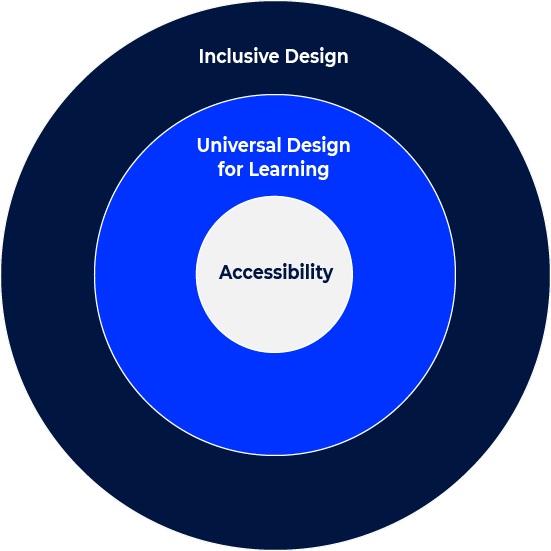Accessibility, UDL and Inclusive Design
UOW is home to a rich and diverse student community. To be able to design inclusive learning experiences that address the diversity of students, it is important to understand and consider some key guidelines and frameworks, including accessibility, Universal Design for Learning (UDL), and Inclusive Design.
What is the difference between accessibility, UDL and Inclusive Design?
Accessibility, UDL, and Inclusive Design all aim to cater to the variability of learners. While there is significant overlap between them, some differences exist.
Accessibility ensures that all people can access and interact with content and the environment. Although accessibility features are often implemented to address individual needs directly, they are often beneficial for many. For example, video captions enabled to support specific student needs, including for students with hearing impairments, while the benefits extend to other students who might turn captions on in noisy environments or for better understanding.
In the online environment, accessibility is achieved by meeting a universally accepted set of standards, the Web Content Accessibility Guidelines.
Universal Design for Learning goes beyond the requirements of accessibility. It is a framework that aims to improve and optimise teaching and learning for all, based on scientific insights into how humans learn. UDL guides the intentional design of learning and teaching experiences through consideration of the ‘what’, the ‘why’ and the ‘how’ of learning, in addition to ‘who’ the learning is designed for.
The Universal Design for Learning in Tertiary Education program, developed by Disability Awareness, is available to UOW staff via Unified Learning.
Inclusive Design considers the full range of human diversity. It focuses on creating learning experiences which ensure that everyone can participate fully and equally by adopting a “solve for one, extend to many” ideology.
How are they connected?
Imagine a target with three rings, each representing an aspect of design that contributes to an inclusive learning experience.

At the centre of the target is accessibility, which ensures that all users can access and interact with content and the environment.
The next ring is UDL, which goes beyond the requirements of accessibility, aiming to optimise learning experiences for all students.
The outermost ring is Inclusive Design. In inclusively designed learning experiences and environments, accessibility and UDL principles are drawn upon. The end goal is to provide an inclusive learning experience, emphasising co-creation, frequent feedback and critical evaluation through an iterative approach.
By drawing on these principles, we can ensure more equal and equitable access to learning experiences for all students.
Guidance and strategies to support the design of inclusive learning environments and experiences is available in the Inclusive learning and teaching collection on the L&T Hub.
Related information
- ADCET: Inclusive teaching | External resource
- ADCET: Inclusive Learning Opportunities Through AI (ILOTA) Podcast series | External resource
- CAST: The UDL Guidelines | External resource
References
CAST (2024). About Universal Design for Learning. https://www.cast.org/impact/universal-design-for-learning-udl
Oregon State University. (2019). Accessibility, Universal Design for Learning (UDL) and Inclusive Design: What do They Really Mean? https://blogs.oregonstate.edu/inspire/2019/12/16/accessibility-universal-design-for-learning-udl-and-inclusive-design-what-do-they-really-mean/#:~:text=UDL%20goes%20beyond%20the%20requirements,have%20more%20work%20to%20do



